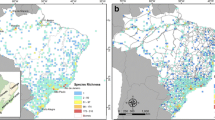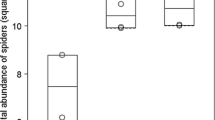Abstract
Intensive fieldwork has been undertaken in Portugal in order to develop a standardized and optimized sampling protocol for Mediterranean spiders. The present study had the objectives of testing the use of semi-quantitative sampling for obtaining an exhaustive species richness assessment of spiders and testing the effects of day, time of day, collector and sampling method on the collected species richness and composition of a Mediterranean scrubland. The collecting summed 224 samples corresponding to one person-hour of effective fieldwork each. In total, 115 species were captured, of which 110 were recorded inside a delimited one-hectare plot, corresponding to more than 70% of the about 160 estimated species. Although no estimator reached the asymptote, the Michaelis-Menten curve behaviour indicates that the estimated richness should be accurate. Most different sampling approaches (day, time of day, collector and sampling method) were found to influence richness, abundance or composition of the samples to some extent, although sampling method had the strongest influence whereas “collector” showed no effect at all. The results support the idea that the only variables that need to be controlled in similar protocols are the sampling methods and the time of day when each method is executed. We conclude that populations in structurally simple habitats present narrower peaks of adult abundance, which implies higher percentages of juveniles in samples. Finally, results also indicate that habitats with a relatively simple structure like scrublands may require as much sampling effort, in order to reach similar proportions of captured species in relation to the estimated richness, as habitats that are much more complex.



Similar content being viewed by others
References
Cardoso P, Silva I, Oliveira NG, Serrano ARM (2004a) Higher taxa surrogates of spider (Araneae) diversity and their efficiency in conservation. Biol Conserv 117:453–459
Cardoso P, Silva I, Oliveira NG, Serrano ARM (2004b) Indicator taxa of spider (Araneae) diversity and their efficiency in conservation. Biol Conserv 120:517–524
Cardoso P, Silva I, Oliveira NG, Serrano ARM (2007) Seasonality of spiders (Araneae) in Mediterranean ecosystems and its implications in the optimum sampling period. Ecol Entomol 32:516–526
Clarke KR (1993) Non-parametric multivariate analyses of changes in community structure. Aust J Ecol 18:117–143
Coddington JA, Griswold CE, Silva-Dávila D, Peñaranda E, Larcher SF (1991) Designing and testing sampling protocols to estimate biodiversity in tropical ecosystems. In: Dudley EC (ed) The unity of evolutionary biology: Proceedings of the Fourth International Congress of Systematic and Evolutionary Biology. Dioscorides Press, Portland, pp 44–60
Coddington JA, Young LH, Coyle FA (1996) Estimating spider species richness in a southern Appalachian cove hardwood forest. J Arachnol 24:111–128
Colwell RK (2005) EstimateS: statistical estimation of species richness and shared species from samples, version 7.5
Dobyns JR (1997) Effects of sampling intensity on the collection of spider (Araneae) species and the estimation of species richness. Environ Entomol 26:150–162
Duelli P (1997) Biodiversity evaluation in agricultural landscapes: an approach at two different scales. Agric Ecosyst Environ 62:81–91
Jones DT, Eggleton P (2000) Sampling termite assemblages in tropical forests: testing a rapid biodiversity assessment protocol. J Appl Ecol 37:191–203
Magurran AE (2004) Measuring biological diversity. Blackwell Science, Oxford
Scharff N, Coddington JA, Griswold CE, Hormiga G, Bjørn PP (2003) When to quit? Estimating spider species richness in a northern European deciduous forest. J Arachnol 31:246–273
Seaby RMH, Henderson PA (2004) Community analysis package 3.0. Pisces Conservation Ltd, Lymington
Silva D, Coddington JA (1996). Spiders of Pakitza (Madre de Dios, Perú): species richness and notes on community structure. In: Wilson DE, Sandoval A (eds) The biodiversity of Southeastern Perú. Smithsonian Institution, Washington, pp 253–311
Sørensen LL, Coddington JA, Scharff N (2002) Inventorying and estimating subcanopy spider diversity using semiquantitative sampling methods in an afromontane forest. Environ Entomol 31:319–330
StatSoft Inc. (2001) STATISTICA: data analysis software system, version 6
Toti DS, Coyle FA, Miller JA (2000) A structured inventory of Appalachian grass bald and heath bald spider assemblages and a test of species richness estimator performance. J Arachnol 28:329–345
Zar JH (1984) Biostatistical analysis. Prentice Hall Inc., New Jersey
Acknowledgements
PC is supported by the Portuguese Foundation for Science and Technology (SFRH/BPD/17351/2004/9ME3). Fieldwork in Vale do Guadiana Nature Park was supported by the Danish Bøje Benzons Foundation.
Author information
Authors and Affiliations
Corresponding author
Rights and permissions
About this article
Cite this article
Cardoso, P., Henriques, S.S., Gaspar, C. et al. Species richness and composition assessment of spiders in a Mediterranean scrubland. J Insect Conserv 13, 45–55 (2009). https://doi.org/10.1007/s10841-007-9116-3
Received:
Accepted:
Published:
Issue Date:
DOI: https://doi.org/10.1007/s10841-007-9116-3




